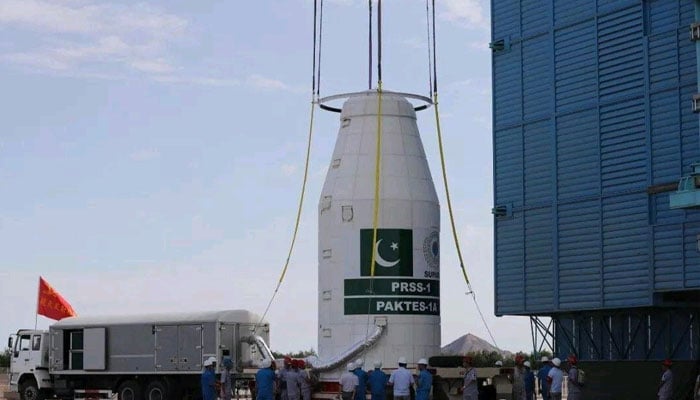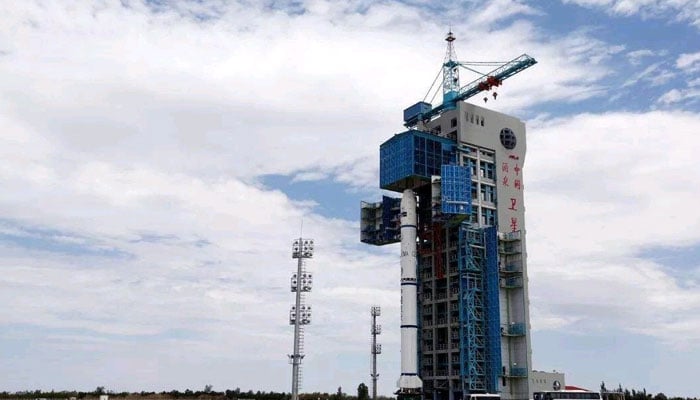Pakistan launched two of its satellites into the orbit from Jiuquan Satellite Launch Centre in China. The satellites, Pakistan Remote Sensing Satellite-1 (PRSS-1) and Pakistan Technology Evaluation Satellite-1A (PakTES-1A), were propelled into space through the Chinese Long March 2C launch vehicle.

According to Pakistan’s Space and Upper Atmosphere Research Commission (SUPARCO), the 1,200-kg mass satellite PRSS-1 will operate in sun-synchronous orbit at an altitude of 640 km. The satellite is equipped with a high resolution optical payload that will enable Pakistan to meet its imagery requirements in the areas of land mapping, agriculture classification and assessment, urban and rural planning, environmental monitoring, natural disaster management and water resource management for socio-economic development of the country.
The PakTES-1A — indigenously designed and developed by SUPARCO’s engineers — has also been co-launched with PRSS-1 by the same launch vehicle. It is a 285-kg satellite equipped with an optical payload commensurating with national needs. It has a design life of three years and will operate in sun-synchronous orbit at an altitude of 610 km. With this launch, SUPARCO’s scientists and engineers have been able to harness critical technologies essentially required for Pakistan’s Satellite Development Programme.
The successful implementation of PRSS-1 and PakTES-1A projects has further strengthened the space cooperation between Pakistan and China for future collaborations.
The PRSS-1 will be mainly used in Pakistan for land resources survey, evaluation, dynamic monitoring and management, resource utilisation, environmental disaster monitoring, agricultural survey, and urban construction.
It will play a positive role in the development of Pakistan’s economy and improve the lives of people. Alongside, it will also provide space remote sensing information services for the China-Pakistan Economic Corridor, which is flagship project of Belt and Road Initiative.
The satellite, which has a designed life of seven years, is equipped with two panchromatic/multispectral cameras, with a resolution up to a meter and a coverage range of 60 km.
Designers say the two cameras are among the best exported remote sensing cameras made by China. They can be used to monitor plant diseases and pests.
The launch marks yet another space cooperation between China and Pakistan since the launch of PAKSAT-1R, a communication satellite, in August 2011.
It is also the first international commercial launch for a Long March-2C rocket within nearly two decades after it carried Motorola’s Iridium satellites into orbit in 1999.
According to Xu Qin, deputy chief designer of the Changjiu Rocket, with the continuous development of China’s remote sensing satellite technology. In May 2016, China and Pakistan had signed a contract for the Pakistan Remote Sensing Double Star Project, and China took the whole star export as an opportunity in the project.
The use of remote sensing satellites independently developed by China has promoted the return of long-two-propane rockets to the international market.
“Before the launch, our model team and the Pakistani side had conducted many communication and coordination, stepped down and batched the task requirements, and provided thoughtful and watchful service, which was highly praised by the Pakistani side”, Guo Wu, deputy commander of the March 2 C rocket added.
Socio-economic benefits
The PRSS-I would provide continuing and improved data that would result in ample of benefits to the nation. The acquired earth observation data would have both public and private uses. The information obtained from PRSS-I can fulfill various purposes, ranging from planning, managing, monitoring and utilization of natural resources thereby improving quality of life. At the same time, commercial and private uses of the same data could provide opportunities for economic growth and benefits for the common man of Pakistan.
Through PRSS-I, the environmental monitoring and management, covering all four environmental domains land, air, coast and marine would be accomplished.
The information derived from PRSS-I could improve knowledge of the supply of freshwater and assist in managing its distribution to water users appropriately.
The most important use of PRSS-I data includes weather/ climate forecasting to track weather-related natural disasters like floods, storms, rain estimates etc, and in accelerating response, recovery and rebuilding efforts immediately afterwards by the relief departments. The accurate weather forecasts are also extremely valuable to determine country’s electricity demand, its generation, uninterrupted supply, electric infrastructure and onwards the cost to consumers which has been a critical issue of Pakistan since several years. It would help to reduce the economic and social costs of managing disasters and electricity demands of Pakistan substantially.
The state of Pakistan’s forests and estimates of the amount of carbon sequestered by them contributing to estimated rates of deforestation and degradation would also be a major benefit of this satellite contributing to the United Nations Collaborative Programme on Reducing Emissions from Deforestation and Forest Degradation (UN REDD+). The acquired data from PRSS-I would provide a broad synoptic view of landscape and an enhanced ability to manage natural resources of the country.
In agriculture sector, the data from PRSS-I can measure several indicators of performance related to irrigated agriculture. More accurate predictions about future weather and climate enable farmers and agribusinesses to estimate future crop yields, leading to reduced uncertainty about yields and prices. SUPARCO is using satellite technology for crop monitoring programs run through the use of satellite imagery, in reference to weather conditions, could add stability to our agricultural markets, thereby improving acquisition of food by under privileged.
The Geographic Information System (GIS) and sophisticated image processing software, as well as the Global Positioning System (GPS) places landscape details into a geographic reference system, incorporating earth observations into routine resource management operations by the respective agencies. Through the use of satellite imagery, national and provincial land management and monitoring departments can be supported to conduct surveys, marking and encroachment of boundaries so that urban developers and land managers may monitor and support decision making for sustainable urban development in the country.
The satellite data may be used to study the spread of several chronic diseases contributing to ensure health and recovery of common public. The GIS data analysis may help in identification and spread of diseases over time, population groups at risk, patterns of disease outbreaks, facility available to healthcare and program intervention planning and assessment in disease outbreak.
The use of macroeconomic production function model by economists could be used to estimate possible impacts of technological changes that would be achieved after launching and utilization of this Remote Sensing Satellite on the country’s GDP and derivative measures such as employments and earnings. The achieved results would be expressed as a rate of return to this investment because it focuses on the totality of the economic impact on the entire national economy.

The Hindukush-Karakoram–Himalaya (HKH) region is considered the backbone of rivers in Pakistan. River Indus emanating from this area is the key source of fresh water which is essential for existence of millions of people living downstream. Water produced by glacial melting along-with perennial snow and ice, contributes to around 70% of the total river Indus flow upstream of Tarbela reservoir. Considering this, SUPARCO is pursuing a comprehensive R&D program on glacier monitoring to provide relevant information about glaciers using time series optical and SAR satellite imagery. Specific areas include glaciers inventorying, glacial hazard mapping, snow and river runoff modeling and impact of climate change on glaciers.
In sum, remote sensing satellites will offer Pakistan the ability to predict and ascertain level of precipitation, and runoff water for a given area. Moreover, it has greater application in agriculture, monitoring and predicting ground water supplies, flooding, drought and atmospheric changes in Pakistan. In doing so, SUPARCO has undertaken landmark projects such as development of geospatial systems for irrigation management, glaciers mapping and monitoring, river and flood vulnerability assessment, crop damage assessment, sea water intrusion mapping and ground water prospection.
Contours of Pakistan National Space Program
National Space Program was approved by Government of Pakistan in 2017 in order to bring benefits of space technology to the people of Pakistan.
National Space Program emphasises to exploit all aspects of space science, technology, and its applications for national well-being and national security.
The mission statement is about “building, launching and operating “communication, remote sensing, weather, and navigation satellites and developing their applications and spin-off technologies for national security and socio-economic development by 2047.”
Some of the key areas of space applications highlighted in Vision 2047 include agriculture, health, education, disaster management, environment, and climate change, land planning, coastal and marine resources, geology and mineral prospection.
Pakistan’s space policy is predominantly devised on technological determinism as it sees its space program for peaceful purposes and for socio-economic development.
Pakistan space launches
Pakistan launched its first experimental satellite BADR-1 in 1990, BADR-1 was indigenously designed and developed satellites flown in space for testing and validation of real-time data communication. BADR-2 was second experimental satellite of Pakistan which was launched in 2001.
PakSAT-1R is the first communication satellite of Pakistan launched from China in 2011 and it is operational in geostationary orbit. ICUBE-1 was student experimental satellite developed by Institute of Space Technology (IST) and it was launched in 2013.
International cooperation
Both satellites were launched from Chinese space launch facility. Pakistan is active observer in United Nations Office for Outer Space Affairs (UNOOSA). Likewise, Pakistan has signed United Nations’ Convention on Register of Objects Launched into Outer Space and it has submitted documents of its all four satellites.
Pakistan’s advance space program is the need of the hour due to growing demand in various sectors including communications, remote sensing, navigation etc.